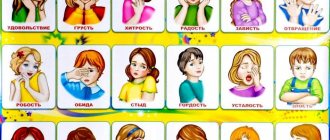Concept and stages of formation
Feelings are often confused with emotions.
These phenomena of the human psyche are interrelated, but are not interchangeable. Feelings are a special form of a person’s relationship to the world around him, which arises as a response to compliance or non-compliance with current needs. They are distinguished by their stability and strength of manifestation. With their help, an individual expresses his attitude towards people, phenomena, objects, and denotes beliefs and character traits. A sensory reaction occurs in response to an event occurring in an individual's life. Correct formation of reactions is necessary for the development of a harmonious, healthy personality. This is an individual process that begins in early childhood. The formation is influenced by the family environment and local culture. In Spain it is customary to express feelings violently, but in Japan this is a sign of poor upbringing.
Feelings are usually divided into lower and higher. The lower ones include physiological manifestations: hunger, fatigue. The highest include manifestations associated with the spiritual world: admiration, empathy, emotional attachment. The presence of higher feelings distinguishes humans from animals.
Sensory experiences have an object reference. An individual cannot experience them for a situation or phenomenon, only for a specific character or object. Feelings may not have external manifestations: while living them inside, the individual remains calm outwardly. They are often nonverbal—unspoken.
Fleeting manifestations occur when interaction with an object has been brief. To form a stable connection, you need long-term contact. This is exactly how falling in love develops: if a person is deprived of the opportunity to see the object of adoration, falling in love quickly passes. If he can look at least at a portrait every day, then love will only be nourished and strengthened.
Functions of emotions
Functions of emotions
The most important characteristic of emotions is its regulatory function. Experiences act as signals that inform a person about how the process of satisfying needs is going. Subjectively, feelings are an indicator of how the process of satisfying his needs occurs: conscious or unconscious, a person compares information about what is required to satisfy the need with what he has at the time of its occurrence. If the likelihood of satisfying a need is high, positive feelings appear. Negative emotions are generated by a real or imagined impossibility of satisfying needs.
Emotional processes, writes S.L. Rubinstein (2000), acquire a positive or negative character depending on whether the action that an individual performs and the impact to which he is exposed are in a positive or negative relationship to his needs, interests, and attitudes. The individual’s attitude towards them and towards the course of activity, which occurs due to a set of objective circumstances in accordance with or contrary to them, determines the fate of his emotions.
Feelings, according to A.V. Zaporozhets, P.Ya. Galperin, perform the role of meaning discrimination: “emotions are the eyes that see the meaning of life” (according to A.D. Kosheleva, 2003).
The appearance of a feeling means a sharp change in the assessment of the object on which the feeling is focused, and in connection with this a change in the assessment of other objects and, consequently, the situation as a whole. Having matured and taken shape, feelings become a powerful means of reorientation in a situation. Feelings are very unique and powerful ways of navigating life's important circumstances. This kind of orientation cannot be replaced by either an intellectual decision or an effort of will. And deep physiological changes (with the acute onset of feelings) and the nervous mechanisms that ensure these changes have developed genetically and, under normal conditions, serve to maintain this orientation and successfully perform subsequent activities (P.Ya. Galperin, 2000, p. 141).
Possible approaches to classifying emotions and feelings
1. According to one of the accepted approaches, a distinction is made between negative, positive and neutral emotions. For example, emotions such as surprise, curiosity, and interest are classified as neutral emotions.
2. Another approach is to distinguish between sthenic and asthenic emotions.
Stenic – emotions characterized by effectiveness. They become motivations for actions, for statements, and increase the tension of forces.
Asthenic emotions are characterized by passivity or contemplation and relax a person.
3. Name lower and higher emotions (feelings).
Lower emotions are given from birth. They are more closely related to the success of need satisfaction. Higher emotions are the result of human social life. The highest feelings are those feelings that include all the richness of a person’s emotional relationships to social reality. The highest feelings are moral, intellectual, aesthetic.
Moral (moral) - express the attitude of a person to a person and, more broadly, to society.
Intellectual feelings - express and reflect the attitude towards the process of cognition, its success and failure.
Aesthetic feelings reflect and express the subject’s attitude to various facts of life and their representation in art as something beautiful or ugly, tragic or comic, sublime or vulgar, elegant or rough.
4. According to another approach, one more group of emotional states can be spoken. In this group there are affects, mood, passion. Intensity and duration in time are criteria for data extraction. Affects are intense but short-term emotional experiences. Passion is an intense and prolonged emotional experience. Mood – low intensity, but long lasting.
5. Another group of emotional states – stress and frustration
Stress is a term used to describe a wide range of human conditions that arise in response to a variety of extreme influences.
Frustration is a mental state caused by failure to satisfy a need or desire. It arises in situations of conflict, when the satisfaction of a need encounters insurmountable or difficult to overcome obstacles (B.G. Meshcheryakov, V.P. Zinchenko, 2006, p. 580).
6. According to the approach of K. Izard (2000), we can talk about a number of basic emotions. These are interest, joy, surprise, suffering, anger, disgust, contempt, fear.
External expressions of emotional states
Emotional states are reflected in facial expressions, breathing, posture, gestures, and vocal characteristics (volume, tone, intonation, tempo) of a person.
Emotional competence
G. Breslav (2004) addresses the category of “emotional competence” and describes existing approaches to the analysis of this phenomenon. Thus, K. Saarni considers emotional competence conceptually and empirically.
Conceptually, emotional competence is the unity of three aspects: “I-identity”, character and developmental history.
Empirically, emotional competence, according to G. Breslav, is a set of eight types of abilities and skills:
a) awareness of one’s own emotional states;
b) the ability to distinguish between the emotions of other people;
c) the ability to use the vocabulary of abilities and forms of expression accepted in a given culture (or subculture), and at more mature stages - the ability to assimilate cultural scripts and associate emotions with social roles;
d) the ability of sympathetic and empathic inclusion in the experiences of other people;
e) the ability to be aware that the internal emotional state does not necessarily correspond to the external expression both in the individual himself and in other people, and at more mature stages - the ability to understand how the expression of one’s own emotions affects others, and to take this into account in own behavior;
f) the ability to cope with one’s negative experiences using self-regulation strategies that minimize the intensity or duration of such experiences (relieve the “severity of the experience”);
g) the awareness that the structure or nature of relationships is largely determined by how emotions are expressed in relationships, namely both the degree of spontaneity, authenticity of expression, and the degree of emotional reciprocity or symmetry in the relationship; for example, mature intimacy is characterized by reciprocity and symmetry in emotional manifestations, while for the relationship between mother and child, the expression of genuine emotions is asymmetrical;
h) the ability to be emotionally adequate, that is, to accept one’s own emotions, no matter how unique or culturally determined they may be, and to correspond to one’s own ideas about the desired emotional “balance” (according to G. Breslav, 2004, pp. 276-277).
Definition of “will”
Will is a person’s conscious regulation of his actions and actions, which require overcoming internal and external obstacles.
Functions of the will
There are two interrelated functions of the will: incentive and inhibitory. The incentive function is provided by human activity. The inhibitory function manifests itself in restraining unwanted manifestations of activity.
The quality that characterizes a person’s tendency to attribute responsibility for the results of his activities to external forces and circumstances or, on the contrary, to his own efforts and abilities, is called localization of control (locus of control).
External (external) localization of control – the subject explains the reasons for his own behavior by external factors.
Internal (internal) localization of control - the subject takes responsibility for his actions, explains them based on his abilities, character, etc.
The most important parts of a volitional act—decision making and execution—often cause a special emotional state, which is described as a volitional effort.
Volitional effort is a form of emotional stress that mobilizes a person’s internal resources (memory, thinking, imagination, etc.), creating additional motives for action that are absent or insufficient, experienced as a state of significant tension (A.V. Petrovsky, 1995, p. 276-278).
Definition of "character"
Character is the originality of mental activity, manifested in the characteristics of an individual’s social behavior and, first of all, in relationships with people, business, and oneself (V.V. Bogoslovsky, 1981, p. 344).
Character is a set of stable individual characteristics of a person that develops and manifests itself in activity and communication, determining the individual’s typical modes of behavior (A.V. Petrovsky, 1995, p. 451).
Character in the narrow sense of the word is a set of stable properties of an individual, which express the ways of his behavior and methods of emotional response (Yu. B. Gippenreiter, 1996, p. 267).
Character Structure
A character can have individual traits or sides, which, however, do not exist in isolation from each other, but are linked together, forming a more or less integral character structure.
The structure of character is revealed in the natural relationship between its individual traits.
Among the character traits, some act as the main, leading ones, setting the general direction for the development of the entire complex of its manifestations. Along with them, there are secondary features, which in some cases are determined by the main ones, and in others may not be in harmony with them. In life there are more integral characters and more contradictory ones.
Character is manifested, firstly, in how he treats other people. The character traits of this group include stable and unstable attachment, integrity and unprincipledness, sociability and isolation, truthfulness and deceit, tactfulness and rudeness.
Secondly, an indicator of a person’s character is the person’s attitude towards himself. This group of character traits includes pride, self-esteem, and self-doubt.
Thirdly, character is revealed in a person's attitude to business. Here there is conscientiousness, diligence, seriousness, enthusiasm, responsibility for the assigned work and concern for its results.
Fourthly, character is manifested in a person’s attitude towards things. One of the manifestations of the character traits of this group is accuracy.
Accentuations of character traits
The quantitative expression of a particular character trait that reaches extreme values and is at the extreme limit of the norm is character accentuation. Accentuation of character is an extreme variant of the norm as a result of strengthening its individual traits.
According to A.E. Lichko can name the following types of accentuations: hyperthymic, cycloid, labile, astheno-neurotic, sensitive. psychasthenic, schizoid, epileptoid, hysterical, unstable, conformal.
A.V. Petrovsky, taking into account the specifics of the teacher’s activity, sees it advisable to keep in mind the following types of character accentuation:
– introverted character type (closedness, difficulty in communicating and establishing contacts with others, withdrawing into oneself);
– extroverted type (emotional responsiveness, thirst for communication and activity, often regardless of its necessity and value, talkativeness, fickleness of hobbies, sometimes boastfulness, superficiality, conformity);
– uncontrollable type – impulsiveness, conflict, intolerance to objections, sometimes suspiciousness;
– neurasthenic accentuation manifests itself in a predominant feeling of ill health, irritability, increased fatigue, suspiciousness, short-term outbursts of anger, rapid exhaustion of the nervous system: anger soon fades and promotes peace, repentance and tears (A.V. Petrovsky 1995, p. 457);
– the sensitive type of character is characterized by fearfulness, isolation, and shyness;
– the demonstrative type is characterized by egocentrism, the need for constant attention to one’s own person, admiration and sympathy. Deceit, a tendency to pose and show off, demonstrative behavior - all this is determined by the desire to stand out among peers by any means. (A.V. Petrovsky, 1995 p. 451-457).
Capabilities
Abilities are those psychological characteristics of a person on which the success of acquiring knowledge, skills, and abilities depends, but which themselves cannot be reduced to the presence of this knowledge, skills, and abilities. Abilities are revealed only in activities that cannot be carried out without the presence of these abilities.
Abilities are revealed not in knowledge, skills, abilities, as such, but in the dynamics of their acquisition, i.e. in how quickly, deeply, easily and firmly the process of mastering knowledge and skills that are essential for a given activity is carried out (A.V. Petrovsky, 1995, pp. 468-470).
Ability is a synthesis of the properties of a human personality that meets the requirements of activity and ensures high achievements in it (V.V. Bogoslovsky, 1981, p. 361).
Abilities are the individual psychological characteristics of a person, which express his readiness to master certain types of activities and to carry them out successfully (Yu.B. Gippenreiter, 1996, p. 246).
Ability Structure
Abilities are a set of mental qualities that have a complex structure.
1. The structure of abilities is determined by the requirements of a specific activity and is different for different types of activity.
2. Among the properties and characteristics of a person that form the structure of specific abilities, some occupy a leading position, some occupy an auxiliary position.
3. We can talk about more general abilities that meet the requirements of not one, but many types of activity, and about special qualities that meet a narrower range of requirements of a given activity.
4. General abilities or general personality qualities are very specific psychological manifestations. Among these general personality qualities, which in the conditions of a specific activity can act as abilities, are individual psychological qualities that characterize belonging to one of two types of people - artistic or thinking.
The artistic type is characterized by the brightness of images that arise as a result of direct influence, living impressions, and emotions. For the thinking type – the predominance of abstractions, the logic of constructions, theorizing.
5. Some essential abilities that together form the structure of mental giftedness. The first feature is attentiveness, composure, constant readiness for hard work. The second personality feature of a highly gifted child, inextricably linked with the first, is that his readiness for hard work develops into a penchant for work, into diligence, into an irrepressible need to work. The third group of features is directly related to intellectual activity: these are features of thinking, speed of thought processes, systematicity of the mind, increased capabilities of analysis and generalization, high productivity of mental activity (A.V. Petrovsky, 1995).
Specific differences in giftedness are found mainly in the direction of interests.
The structure of special talent includes the ensemble of the above personality qualities and is supplemented by a number of abilities that meet the requirements of a specific activity.
Ability Levels
Inclinations are morphological and functional features of the structure of the brain, sensory organs and movement, which act as natural prerequisites for the development of abilities.
The reproductive level is a high ability to assimilate knowledge, master activities and carry them out according to the proposed model.
The creative level is the ability to create something new, original (V.V. Bogoslovsky, 1981, p. 362).
The highest level of development of abilities is called talent. Talent is a combination of abilities that gives a person the opportunity to successfully, independently and originally perform any complex work activity. Talent is a combination of abilities, their totality. A single, isolated ability cannot be an analogue of talent, even if it has reached a very high level of development and is clearly expressed.
Talent in the totality of its general and special qualities is only an opportunity for creative success, only a prerequisite for mastery, but not yet mastery. Talent is an opportunity, skill is an opportunity that has become reality. True mastery is the manifestation of a person’s talent in activity. Mastery is revealed not only in the sum of the corresponding ready-made skills and abilities, but also in mental readiness for the qualified implementation of any labor operations that will be necessary for a creative solution to the problem that has arisen (A.V. Petrovsky, 1995, p. 480).
Talent and genius. Talented and brilliant people achieve new results in practice, art, and science that are of great social importance. A person of genius creates something original that opens up new paths in the field of scientific research, production, art, and literature. A talented person also creates, contributes his own, but within the framework of already defined ideas, directions, methods of research (V.V. Bogoslovsky, 1981).
Age stages of development
The development of feelings in early childhood is an important, complex process. It happens in stages:
- Newborn baby. Once born, a child masters the basic forms of manifestations necessary for survival: hunger, pleasure, pain, fear. The emotional state depends on physical sensations. A newborn does not know how to distinguish between feelings. His main interest and need is physical contact with his mother. The baby reacts to her mood and copies it.
- From 0 to 6 months. The baby understands what sensations he experiences when in contact with adults. His perception is fragmentary: he sees the world in parts. By six months, he learns to distinguish between family and strangers; anxiety and wariness appear in his arsenal. While exploring the world, he tries to touch everything he sees. If this fails, the baby experiences anger and discomfort.
- 6–12 months Six-month-old babies know how to be surprised and show interest. In addition to physical needs, the child has mental ones. Interests gradually form: the child divides toys into favorites and unloved ones. At the age of 8 months, fear of separation from the mother appears, the child experiences anxiety and becomes restless.
- 1–1.5 years. Own desires appear, the need to realize them. The child learns to make independent decisions, but often faces prohibitions from adults. An obstacle causes anger and a desire to get what is yours. At this age, it is important to learn to separate desires and actions. The main achievement of 1.5 years is that the child develops an idea of himself, the baby identifies himself with his name.
- 1.5–2 years The child is no longer helpless. He moves confidently, can pick up a toy himself, and has more freedom and needs. He strives to prove independence, the right to his own opinion. At this age, he already shares feelings, but cannot name them.
- 2–2.5 years Two-year-old children see themselves as the center of the world; they have no understanding of danger. Also, the feeling of compassion and pity has not yet been formed: if the child does not like another baby, he may hit him or bite him, expressing hostility.
- 2.5–3 years. With successful development, by the age of three the child will have formed a holistic idea of himself. There is pride in one’s independence and shame in case of failure. Interest in other children awakens, the desire to take their place in the team.
The development of feelings continues until the end of adolescence. The first years of life form the foundation that will help a child differentiate feelings from emotions.
Adaptation of a child in a team
Qualitative characteristics
Feelings have characteristics that distinguish them from other emotional manifestations:
- Valence - division into positive, negative and ambivalent (dual). The occurrence of ambivalent manifestations speaks of rich life experience and lack of categoricalness. Ambivalence is characteristic of people with a high level of intelligence.
- Intensity is the power of manifestation. By intensity, one can determine the main and secondary feelings, assess a person’s ability to self-control, and the development of willpower.
- Content is the meaning for a person of an object in relation to which he shows feelings.
- Sthenicity is an urge to action, a desire to express a feeling. If a person tries to restrain manifestations, this is called asthenicity.
The intensity of the manifestation of feelings determines the behavior of the individual and the attitude of other people towards him. Emotions are always sincere, and the demonstration of feelings can be planned in advance.
Psychophysiology of emotionsIrina Poletkina, 2012
1. FUNCTIONS OF EMOTIONS
Emotions play an extremely important role in people's lives. Thus, today no one denies the connection between emotions and the functioning of the body. It is well known that under the influence of emotions the activity of the circulatory, respiratory, digestive organs, endocrine and exocrine glands, etc. changes. Excessive intensity and duration of experiences can cause disturbances in the body. M.I. Astvatsaturov (1936) wrote that the heart is more often affected by fear, the liver by anger, and the stomach by apathy and a depressed state. The occurrence of these processes is based on changes occurring in the external world, but affects the activity of the entire organism.
In addition to the fact that emotions perform the function of regulating the state of the body, they are also involved in regulating human behavior in general. This became possible because human emotions have a long history of phylogenetic development, during which they began to perform a number of specific functions that are unique to them.
Researchers have identified several functions of emotions: reflective (evaluative), pre-information (signal), stimulating, reinforcing, switching, communicative.
Reflective function of emotions
expressed in a generalized assessment of events. Emotions cover the entire body and thereby produce almost instantaneous integration, generalization of all types of activities that it performs, which allows us to first determine the usefulness and harmfulness of the factors affecting it and react before the localization of the harmful effects is determined.
This function is more obvious for such experiences as anger, hatred, shame, since they are directly connected with reactions, while for experiences of pleasure, suffering, joy, boredom, it is not always possible to determine their causes. A person’s emotional evaluative abilities are formed not only on the basis of the experience of his individual experiences, but also as a result of emotional empathy that arises in communication with other people, in particular through the perception of works of art and the media. That is, a person’s emotional experience is much broader than the experience of his individual experiences. And this is one of the factors in the development of a person’s emotional sphere.
The study of the reflective function of emotions led P.V. Simonov to the development of need-information theory,
according to which “emotion is a reflection by the brain of humans and higher animals of any actual need (its quality and magnitude) and the probability (possibility) of its satisfaction, which the subject involuntarily evaluates on the basis of innate and previously acquired individual experience.”
Emotions also perform pre-information,
or
signaling
function.
Life without emotions is just as impossible as life without sensations. Emotions, Charles Darwin argued, arose in the process of evolution as a means by which living beings establish the significance of certain conditions to satisfy their actual needs. Emotionally expressive movements (facial expressions, gestures, pantomime) serve as signals about the state of the human needs system. The experiences that arise signal to a person how the process of satisfying his needs is going, what obstacles he encounters on his way, what he needs to pay attention to first, etc.
The evaluative or reflective function of emotions is directly related to its motivating function.
Emotion reveals the search zone where a solution to a problem or satisfaction of a need will be found.
Emotional experience contains an image of the object of need satisfaction and one’s biased attitude towards it, which prompts a person to action. Two classes of emotions, according to V.K. Vilyunasu, leading and situational (or derivatives) - have the function of motivation. The leading emotional experience
directed at the object—the goal of behavior that satisfies the need—initiates adaptive behavior itself.
Situational emotional experiences
that arise as a result of assessments of the results of individual stages of behavior also encourage the subject to act in the same direction or change tactics of behavior, behavior itself, and means of achieving the goal.
The reinforcing function of emotions.
It is known that emotions are directly involved in the processes of learning and memory. Significant events that cause emotional reactions are imprinted in memory faster and for a long time. Thus, a well-fed cat cannot develop conditioned food reflexes. Successful learning requires the presence of motivational arousal, in this case reflected in the feeling of hunger. However, the combination of an indifferent stimulus with hunger excitation is not yet sufficient for the development of conditioned food reflexes. A third component is required - the influence of a factor that can satisfy the existing need - food. In the experiments of T.N. Oniani, who combined an external stimulus with electrical stimulation of the limbic structures of the brain, causing a need for food in a well-fed cat, managed to develop only a conditioned reaction of avoidance and fear. But it was not possible to obtain conditioned reflexes of food. The main reason is that the electrical stimulation of the limbic structure, used as reinforcement, did not contain a reward—the satisfaction of a need.
It is also impossible to develop conditioned reflex hunger if you combine indifferent stimuli - environmental signals with the state caused by food deprivation. In such an animal, in response to the experimental situation, it is not the search for food behavior that is developed, but a reaction of fear and avoidance. That is, the indifferent stimulus is associated with the avoidance reaction with which the animal responds to a situation of prolonged starvation, since this reaction reduces fear.
Thus, the real reinforcement for the development of a conditioned reflex (classical and instrumental) is a reward.
The reward for a hungry animal can be food.
Under natural conditions, human activity and animal behavior are determined by many needs at different levels. Their interaction is expressed in the competition of motives that manifest themselves in emotional experiences. Evaluations through emotional experiences have motivating power and can determine the choice of behavior. As was shown earlier using the example of intellectual emotions, the “emotional premonition of solving a problem” encourages the completion of actions in the selected search zone, and the “premonition of a contradiction” prompts a change in this zone. Essentially, emotions of success and failure have the ability to encourage a person to switch from one action to another. In particular, this already expresses the switching function of emotions.
Switching function of emotions
It is especially clearly revealed in the competition of motives, as a result of which the dominant need is determined. Thus, in extreme conditions, a struggle may arise between the natural human instinct of self-preservation and the social need to follow a certain ethical norm. It is experienced in the form of a struggle between fear and a sense of duty, fear and shame. The outcome depends on the strength of motives and personal attitudes.
Communication function
lies in the fact that emotions, or more precisely, the methods of their external expression, carry information about the mental and physical state of a person. Thanks to emotions, we understand each other better. By observing changes in emotional states, it becomes possible to judge what is happening in the psyche. People belonging to different cultures are able to accurately perceive and evaluate many expressions of the human face, and identify from it such emotions as joy, anger, sadness, fear, disgust, surprise. This also applies to those peoples who have never been in direct contact with each other.
Mimic and pantomimic movements allow a person to convey his experiences to other people, inform them about his attitude towards phenomena, objects, etc. Facial expressions, gestures, postures, expressive sighs, changes in intonation are the “language of human feelings”, a means of communicating not so much thoughts, so many emotions.
A major role in the study of expressive movements was played by Charles Darwin’s work, “The Expression of Emotions in Man and Animals,” published in 1872. Comparing the expression of emotions in humans and domestic animals, he came to the conclusion that the muscle movements with which a person expresses his emotions originated from similar motor acts of our ancestors.
There are genetically specified universal complexes of behavioral reactions that express the emergence of basic fundamental emotions. Genetic determination of expressive reactions
is confirmed by the similarity of expressive facial movements in blind and sighted people (smile, laughter, tears).
The differences in facial movements between blind and sighted young children are very small. However, with age, the facial expressions of sighted people become more expressive and generalized, while in the blind they not only do not improve, but even regress. Consequently, facial movements not only have a genetic determinant, but also strongly depend on training and upbringing.
It should be noted that if, by comparing emotions caused by the same object in different people, one can detect a certain similarity, then other emotional manifestations in people are strictly individual. The variety of emotional manifestations is expressed primarily in the prevailing mood of people. Under the influence of life conditions and depending on the attitude towards them, some people have a high, cheerful, cheerful mood; for others - depressed, depressed, sad; for others - capricious, irritable, etc.
Significant individual differences are also observed in the emotional excitability of people. There are people who are emotionally unsensitive, for whom only some extraordinary events evoke pronounced emotions. Such people do not so much feel when they find themselves in this or that life situation as they recognize it with their minds. There is another category of people - emotionally excitable ones, in whom the slightest trifle can cause strong emotions. Even an unimportant event causes their mood to rise or fall.
There are significant differences between people in the depth and stability of feelings. Some people are completely overwhelmed by their feelings and leave a deep imprint behind them. For other people, feelings are superficial, flow easily, unnoticeably, pass quickly and completely without a trace. Manifestations of affects and passions differ noticeably among people. In this regard, we can identify people who are unbalanced, who easily lose control over themselves and their behavior, who tend to easily succumb to affects and passions, for example, unbridled anger, panic, and excitement. Other people, on the contrary, are always balanced, completely in control of themselves, and consciously control their behavior.
One of the most significant differences between people lies in the way feelings and emotions are reflected in their activities. So, for some people, feelings are effective in nature and encourage action, while for others everything is limited to the feeling itself, which does not cause any changes in behavior. In its most vivid form, the passivity of feelings is expressed in human sentimentality. Such people, as a rule, are prone to emotional experiences, but the feelings they have do not affect their behavior.
Functions and meaning
The task of the senses is to receive and classify information about objects. They also have separate functions:
- reflective - helps to assess the level of danger and usefulness of objects in order to respond to the threat in time;
- stimulating - encourages you to take active actions, make plans for the future, look for ways to solve complex problems, motivation;
- reinforcing - helps to assess the significance of an event for an individual, to remember important things;
- switching - tells you which category to classify objects, actions into, and set priorities;
- adaptive - forms a ready-made base of manifestations that a person has already experienced;
- communicative - affects relationships with others, the need for communication, helps to establish emotional contacts.
Only a positive social environment can ensure normal functioning of functions. If a function malfunctions, a person’s emotional intelligence does not develop. A low level of emotional intelligence is characteristic of children who were raised in a disadvantaged environment.
An extreme degree of manifestation of pedagogical neglect in Mowgli children who grew up away from people. They do not distinguish between the manifestations of other people and do not know how to express feelings. Their psychological development is at the level of a baby monkey.
Classification by types and scope of manifestation
Feelings are varied and sometimes a person cannot explain what he is experiencing. To simplify the assessment process, you should use the classification of types of feelings in psychology:
- Subject - refer to the basic spheres of human reality. They show reactions to various actions of others: irritation, delight, surprise, anger.
- Intellectual - desire for new experiences: curiosity, anticipation, doubt.
- Aesthetic - a reaction to beautiful, ugly objects: experiences of admiration, disgust, pleasure, dissatisfaction.
- Praxic - associated with the choice of activity. They determine the attitude towards responsibilities: determination, thirst for knowledge, satisfaction.
- Moral - responsible for the interaction of people, personal assessment of what is permissible and unacceptable: patriotism, love, cruelty, selfishness.
Complex feelings cannot be classified into one category; they are always a combination of 2-3 different experiences. For example, love can encourage one to gain knowledge, change activities, and unlock potential. Resentment can cause irritation, despair, and apathy.
Forms of manifestations and physiology
Emotions in psychology, the classification of which divides them into simple (basic or fundamental) and complex, can have varying degrees of expression and emotional tone, and differ in the form of manifestation.
Soviet psychologist A. N. Leontiev in his works (1971) identified 3 forms of emotions:
- Affect is a short-term and strong surge of emotions as a reflexive reaction to the current situation (sudden joy, sudden fear, panic attack). Accompanied by physiological changes in the body (changes in motor activity, secretion functions, activity of the cardiovascular system) and can adversely affect health.
- Emotions themselves have a less pronounced sensitive coloring, reflect the subjective reaction of the individual in various situations, and are able to prevent the occurrence of undesirable reactions in the future.
- Object feelings are stable emotions that reflect the subjective assessment of an individual in relation to a specific object.
S. Rubinstein (1946), in addition to affect, feelings and emotions, identifies 2 more forms of emotional manifestations:
- Mood is a long-term stable emotional state of a person, formed on the basis of his personal experiences and the general state of satisfaction of needs.
- Passion – an emotional state with pronounced coloring and depth, aimed at a specific goal.
Stress is distinguished separately in psychology - as a nonspecific emotional reaction in response to unfavorable extreme situations from the outside.
Emotions can influence not only a person’s state of mind and mood, but also the physiological indicators of the body:
- change the lumen of blood vessels (a person becomes embarrassed and blushes, blood rushes to the face when the blood vessels dilate, and when frightened, the skin may turn pale and constriction of blood vessels may be observed);
- speed up the heartbeat;
- influence motor activity (stupor or acceleration of reaction);
- change the depth and speed of breathing;
- affect the digestive tract (intestinal upset, heaviness in the abdomen);
- change blood pressure levels;
- influence muscle tone;
- increase sweating and heat transfer processes, the activity of the lacrimal glands;
- influence the activity of the glands of the endocrine system (changes in sugar levels, adrenaline release).
Effect on mood
In psychology, mood is an emotional state at a specific moment in time. Mood is rarely accompanied by a strong emotional reaction, but affects all activities. It creates a background that determines the speed and efficiency of work. Normally, the mood is stable. In individuals with a strong nervous system, it changes less frequently; in sensitive people, the change occurs frequently.
The mood has a pointless character. Even if a person understands what specifically caused dissatisfaction, the bad mood spreads to activities and relationships. Mood affects feelings. In a bad mood, people experience irritation and injustice towards themselves. In a good situation, they are ready for selfless actions, a favorable attitude towards an unpleasant person.
Boundaries of the concept
Emotions in psychology are a broad concept that covers (depending on their classification) various manifestations of feelings, experiences, emotional reactions and states.
However, there are significant differences between emotions and feelings. Emotions most often arise as an abstract state that has no connection to a particular object. They reflect the individual's general attitude towards the situation.
Feelings, on the contrary, have a specific connection to an object: a person feels love for someone, is afraid of something, is angry with someone. For example, a person in love experiences joy and is in a good mood. At the same time, love is a feeling for a certain person, and joy is an emotion that arises as a result of the feelings he experiences (subjective reaction to the situation).
Short-term emotions that have a pronounced manifestation are usually called affect, and long-term and more stable manifestations of deep-seated emotions are called feelings.
Similarities and differences with emotions
Emotions and feelings in psychology have an inseparable connection: they form the emotional background. Often the individual does not see the difference between them. But they differ in duration, depth, and degree of manifestation.
Feeling is a person’s deep, stable attitude towards an event or phenomenon. It is often hidden, it can be consciously suppressed, masked. Containing emotions is more difficult. They appear as a short burst, a fleeting reaction. Emotions manifest themselves unconsciously. Feelings are conscious manifestations aimed at a specific goal. Emotions can be experienced without external stimulus. For example, an individual experiences strong emotional excitement when listening to music or watching a movie. He empathizes with fictional characters.
When experiencing emotions, a person gives a subjective assessment of what is happening. It depends on the characteristics of his nervous system: phlegmatic people are low-emotional, and choleric people find it difficult to restrain themselves. Sanguine people easily experience strong emotions, but they cause inconvenience to melancholic people. It is impossible to change the characteristics of the nervous system, but you can learn to control emotions. To do this, an individual must distinguish between emotions and feelings and not be afraid of the negative spectrum of emotions.
Types of emotions
The most ancient and primitive type of emotional states are states of pleasure and displeasure, which are classified as the simplest organic sensitivity. These experiences are associated with the satisfaction (or dissatisfaction) of natural needs and are felt by a person even more physiologically than psychologically. For example, when, after a long and tiring day spent on your feet, you sit down in a soft, comfortable chair.
But most of our emotional states are “humanized,” that is, they are conscious in nature and associated with activity and social relationships.
Moods
This is the most generalized type of emotional states. Moods, on the one hand, are weakly expressed, and on the other hand, they create the background of all our activities, as if coloring our life at one stage or another.
The mood is quite stable. Changing it depends not only on the situation, but also on personal characteristics. In people with a mobile nervous system, moods are less stable and change frequently.
The most important characteristic of mood is its non-objective character. This emotional state creates a background, but is not associated with a specific subject. Although a person may well be aware of the circumstance that spoiled his mood, the emotion itself extends not only to this circumstance, but also affects activity (everything falls out of hand, you want to quit everything, etc.) and interpersonal relationships. Often we take our bad mood out on those who have nothing to do with it, or share our joyful well-being with the whole world.
Emotions
Actually, emotions (in the narrow sense) and feelings are quite close and similar, and psychologists are still arguing which of these emotional states can be attributed to a higher level and which is more primitive. But this is important for science, but does not play a role in everyday life.
Emotions themselves are more short-lived than moods, but also more clearly expressed. The power of expression of emotions is also much higher than that of mood. Emotions are more conscious of a person, and he clearly differentiates them: joy and anger, fear and hatred, pleasure and hostility.
But the main difference between emotions and moods is that they are objective and aimed at a specific object or situation. These emotional states are social in nature, that is, they are part of the communication process; a person conveys his emotions (with the help of facial expressions, pantomime, intonation, gestures) to other people and is able to perceive them, empathize, and sympathize with others.
Emotions have another unique feature - we are able to experience them in relation not only to a real situation, but also to an imaginary one. Memories and adventures of the heroes of books and films can also evoke emotions.
Feelings
This type of emotional state, just like emotions, is associated with certain objects. We love or hate very specific people, phenomena and situations. It is generally impossible to love, to experience feelings of respect or hostility. But feelings are longer lasting, more stable than emotions, deeper and more varied. And we can also say that feelings are more socialized and depend on a person’s interaction with the people around him. Therefore, feelings are varied, and there are several types of them:
- objective feelings are the largest variety of feelings associated with various aspects of human existence; these include, for example, admiration and disgust, feelings of the sublime and a sense of humor (comic);
- moral feelings are associated with relationships in society (love, hatred, sense of duty, friendship, envy, etc.);
- intellectual feelings are associated with cognitive needs (curiosity, inquisitiveness, a sense of mystery, doubt, confidence, etc.);
- aesthetic feelings arise in response to the perception of the beautiful or ugly in nature and art; in general, they can be characterized as the experience of pleasure or displeasure, pleasure or disgust, etc.
This classification, of course, is not entirely accurate and complete, since any feeling is essentially subjective. But it reflects quite well the diverse and colorful palette of human feelings.
Affect and stress
Affect is a very strong and vivid emotional response to a sudden situation that threatens a person’s health and life. The effects are short-lived, but they are expressed in a sharp activation of all the protective functions of the body. We can say that all the strength and hidden reserves of a person are directed towards getting rid of the cause of such strong negative emotions.
Cases are described when, in a state of passion, people jumped over four-meter fences and climbed tall trees. There was even a case recorded when a woman, saving a child from under the wheels of a car, was able to turn it over into a ditch by hitting the side of a small truck with her hands.
The peculiarity of affect is that it is accompanied not only by a powerful release of physical and emotional energy, but also by a state of altered consciousness. It manifests itself in a person’s loss of rational control over his actions. The subject seems to fall out of reality, and then cannot remember what he did in a state of passion. In criminology, murders committed in this state are classified as special types of crimes, since the person is not aware of his actions and does not control them.
After the affect comes a “rollback” - having used up all his strength, even internal reserves, a person feels weak, his hands tremble, his legs become “wobbly,” and sometimes he even loses consciousness.
Stress is similar to affective states in that it occurs as a response to a traumatic or threatening situation. But it is less strong and longer lasting. What is important is that stress is not accompanied by a change in consciousness and a shutdown of rational control. Although a person immersed in the cycle of his problems may not realize that he lives in a state of stress.
Stress also activates the body’s strengths, not only physical, but also intellectual. But in the initial stages this is felt as increased tone and a kind of stimulation of activity, and internal reserves are not spent. Only prolonged stress is harmful to a person, which leads to overload of the nervous system, chronic fatigue syndrome, and even depression.










